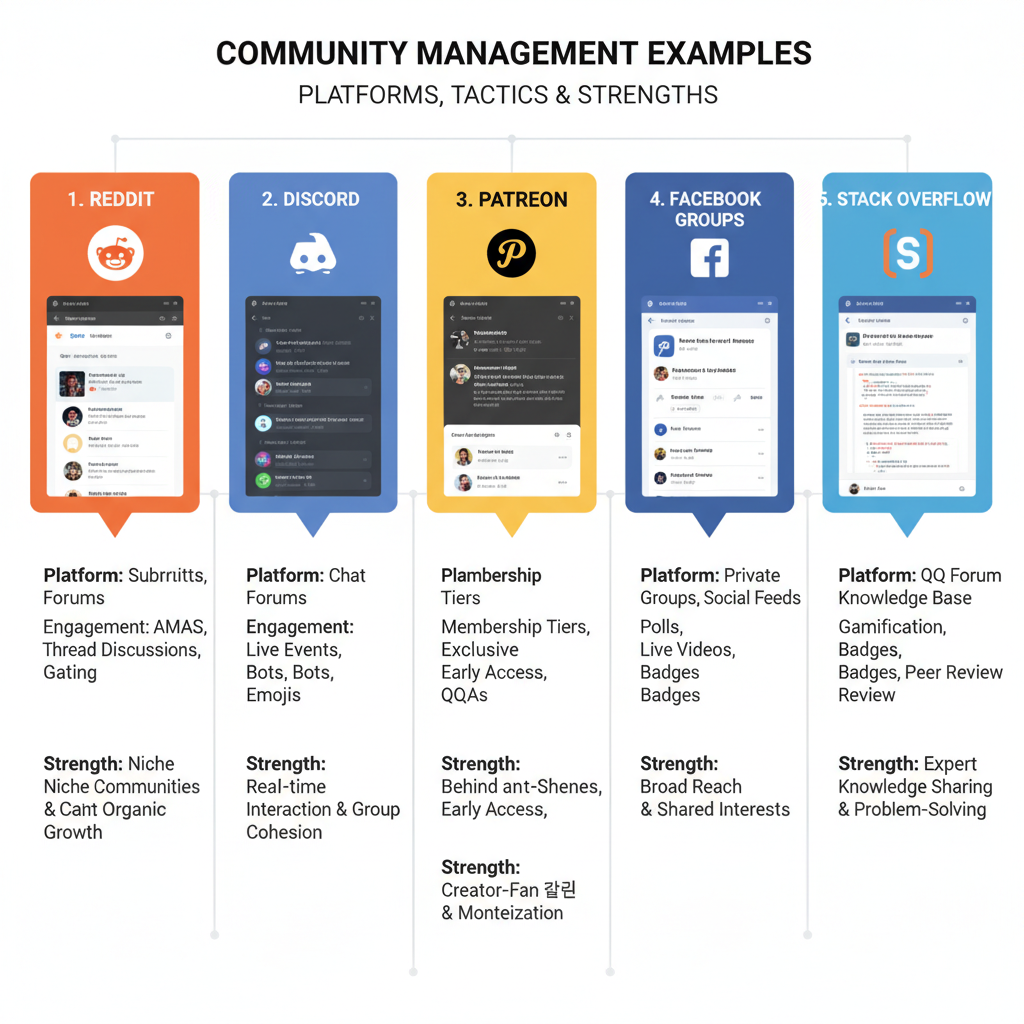Best Community Management Examples for Successful Strategies
Explore real-world community management examples with proven tactics for boosting engagement, fostering loyalty, and driving measurable success.

Introduction to Community Management and Its Importance
Community management is a critical skill for brands, organizations, and influencers seeking to deepen audience engagement and foster long-term loyalty. In today’s digital-first world, knowing how to manage a community effectively can boost retention, attract advocates, and even drive innovation. The best community management examples highlight how thoughtful connections between members create value for both the community and the organization.
At its core, community management means building, sustaining, and enriching member relationships while aligning participation with broader goals. Strong communities become self-sustaining ecosystems where peer-to-peer support, co-creation, and feedback loops accelerate growth and trust.

---
Defining What Makes a “Good” Community Management Example
Not every community flourishes organically. The strongest community management examples tend to embody these traits:
- Clarity of Purpose – Members understand the mission and reason for joining.
- Authentic Engagement – Interactions are genuine, with minimal corporate jargon.
- Consistency – Regular updates, activities, and communication sustain momentum.
- Value Creation – Participating yields tangible benefits, whether knowledge, connections, or exclusive offers.
- Scalability – Growth does not dilute the original culture or member intimacy.
Good examples also show measurable success via metrics like engagement rates, sentiment analysis, and member retention.
---
Example 1: Brand-Led Online Forum (Case Study + Key Tactics)
One standout example is a tech company’s branded online forum designed for customers and enthusiasts. Acting as a central repository for solutions, tutorials, and product discussions, this community ensures members can help each other while the brand maintains quality control.
Case Study:
- Brand: Global software provider
- Platform: Proprietary forum software with SEO-friendly indexing
- Membership: 150,000+ active users
Key Tactics Used:
- Expert Moderation – Company staff respond within hours.
- Peer Recognition Badges – Gamification rewards helpful contributions.
- SEO-Optimized Threads – User-generated posts rank high in search results.
This setup gives the company ownership of the platform while empowering members to collaboratively problem-solve.

---
Example 2: Engaged Facebook Group with Active Moderation
Facebook Groups remain popular for cultivating niche communities. A lifestyle brand’s private customer group showcases high engagement rates backed by proactive moderation.
Highlights:
- Moderation: Admins in various time zones for round-the-clock oversight.
- Content Strategy: Weekly challenges, exclusive behind-the-scenes content, and polls.
- Engagement Rate: 76% monthly active participation.
Tactics That Worked:
- Rules & Guidelines – A clear policy curtails spam and conflict.
- Member Spotlights – Public recognition boosts morale and effort.
- Event Integration – AMA sessions with founders strengthen brand affinity.
Leveraging Facebook’s built-in tools alongside a warm tone ensures community members feel connected and valued.
---
Example 3: Niche Discord Server for Product Feedback
Discord offers real-time communication perfect for iterative product development. A gaming startup’s Discord server streamlined feedback collection before public release.
Features of the Server:
- Topic-Specific Channels – Organized spaces for bug reports, feature ideas, beta sign-ups.
- Voice Chat Feedback Sessions – Direct conversations between developers and players.
- Role-Based Access – Exclusive privileges for beta testers and power users.
Impact:
Instant two-way communication shortened development cycles, empowering the team to roll out weekly updates tailored to user needs.
---
Example 4: Non-Profit Community Building Strong Offline Ties
Even in a digital era, offline touchpoints remain vital. One non-profit combines online coordination with face-to-face engagement to build robust member ties.
Strategies:
- Local Meetups – Monthly events deepen trust and shared mission alignment.
- Volunteer Coordination – Digital boards manage logistics efficiently.
- Storytelling Campaigns – Success stories fuel morale and attract new supporters.
The hybrid model keeps members bonded by purpose beyond the screen.

---
Example 5: Hybrid Approach Blending Social Media + Events
A health and wellness brand illustrates how blending online and offline engagement maximizes reach.
Key Components:
- Pre-Event Hype Content – Short-form videos drive anticipation.
- Post-Event Sharing – Attendee-generated posts expand visibility.
- Cross-Platform Consistency – Unified tone and visuals across Instagram, TikTok, and retreats.
The strategy delivers convenience through digital channels alongside credibility earned from real-life interactions.
---
Lessons Learned Across All Examples
Studying the best community management examples reveals universal lessons that apply cross-industry:
| Lesson | Description | Benefit |
|---|---|---|
| Engagement | Members need regular prompts via posts, events, or discussions. | Maintains participation and return visits. |
| Transparency | Honest communication about changes and decisions fosters trust. | Encourages loyalty and advocacy. |
| Gamification | Challenges, badges, and rewards add fun to participation. | Significantly boosts interaction metrics. |
| Accessibility | Inclusive language and streamlined onboarding broaden appeal. | Expands potential member base. |
---
Tips for Applying These Practices to Your Own Community
- Choose the Right Platform – Align with where your audience naturally gathers.
- Start Small, Scale Smart – Test initiatives before expanding.
- Track Key Metrics – Monitor engagement, sentiment, and conversions.
- Encourage User-Generated Content – Diverse perspectives enrich community culture.
- Close Feedback Loops – Show impact by implementing member suggestions.
Pro Tip: Combine asynchronous forums with real-time chats to cater to varied interaction styles.
---
Conclusion and Call to Action
Effective community management is built on purpose, authenticity, and a commitment to member success. From brand-led forums to niche Discord groups, the best community management examples prove that engagement, transparency, and thoughtful content design foster trust and growth.
Ready to launch or refine your own community? Define its mission, select the right platform, and employ these proven tactics. The sooner you start, the sooner you’ll build a vibrant, resilient network that benefits everyone involved. Start today and become the example others aspire to follow.



